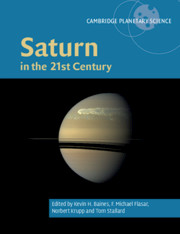Book contents
- Saturn in the 21st Century
- Cambridge Planetary Science
- Saturn in the 21st Century
- Copyright page
- Contents
- Contributors
- Reviewers
- 1 Introduction to Saturn in the 21st Century
- 2 The Origin and Evolution of Saturn, with Exoplanet Perspective
- 3 The Interior of Saturn
- 4 Saturn’s Magnetic Field and Dynamo
- 5 The Mysterious Periodicities of Saturn
- 6 Global Configuration and Seasonal Variations of Saturn’s Magnetosphere
- 7 Saturn’s Aurorae
- 8 Saturn’s Ionosphere
- 9 Saturn’s Variable Thermosphere
- 10 Saturn’s Seasonally Changing Atmosphere
- 11 The Global Atmospheric Circulation of Saturn
- 12 Saturn’s Polar Atmosphere
- 13 The Great Saturn Storm of 2010–2011
- 14 The Future Exploration of Saturn
- Index
- References
2 - The Origin and Evolution of Saturn, with Exoplanet Perspective
Published online by Cambridge University Press: 13 December 2018
- Saturn in the 21st Century
- Cambridge Planetary Science
- Saturn in the 21st Century
- Copyright page
- Contents
- Contributors
- Reviewers
- 1 Introduction to Saturn in the 21st Century
- 2 The Origin and Evolution of Saturn, with Exoplanet Perspective
- 3 The Interior of Saturn
- 4 Saturn’s Magnetic Field and Dynamo
- 5 The Mysterious Periodicities of Saturn
- 6 Global Configuration and Seasonal Variations of Saturn’s Magnetosphere
- 7 Saturn’s Aurorae
- 8 Saturn’s Ionosphere
- 9 Saturn’s Variable Thermosphere
- 10 Saturn’s Seasonally Changing Atmosphere
- 11 The Global Atmospheric Circulation of Saturn
- 12 Saturn’s Polar Atmosphere
- 13 The Great Saturn Storm of 2010–2011
- 14 The Future Exploration of Saturn
- Index
- References
Summary
Saturn formed beyond the snow line in the primordial solar nebula, and that made it possible for it to accrete a large mass. Disk instability and core accretion models have been proposed for Saturn’s formation, but core accretion is favored on the basis of its volatile abundances, internal structure, hydrodynamic models, chemical characteristics of protoplanetary disk, etc. The observed frequency, properties, and models of exoplanets provide additional supporting evidence for core accretion. The heavy elements with mass greater than 4He make up the core of Saturn, but are presently poorly constrained, except for carbon. The C/H ratio is super-solar, and twice that in Jupiter. The enrichment of carbon and other heavy elements in Saturn and Jupiter requires special delivery mechanisms for volatiles to these planets. In this chapter we will review our current understanding of the origin and evolution of Saturn and its atmosphere, using a multi-faceted approach that combines diverse sets of observations on volatile composition and abundances, relevant properties of the moons and rings, comparison with the other gas giant planet, Jupiter, and analogies to the extrasolar giant planets, as well as pertinent theoretical models.
- Type
- Chapter
- Information
- Saturn in the 21st Century , pp. 5 - 43Publisher: Cambridge University PressPrint publication year: 2018
References
- 22
- Cited by



